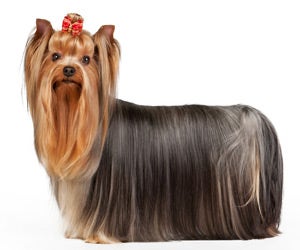Yorkshire Terrier
-
Overview
View Grooming Diagram for yorkshire terrierEven though they are only about 7 or 8 inches tall, Yorkshire Terriers are an inquisitive toy breed who love to search for adventure and show off their runway-ready locks.
Yorkies are popular portable pups who have become famous for their glamorous coats and cheerful expressions. They require some consistent training and socialization, not to mention brushing, to stay healthy and happy.
-
Personality
-
Coat Care

Yorkies do not shed, but if their coats are kept long, they require significant brushing and care to prevent matting and tangles and keep the hair shiny.
With preparation, perseverance and a positive attitude, bathing can become a fun and fulfilling part of the regular grooming cycle, while helping your dog avoid many diseases and infections.
The general rule of thumb for dog bathing is every three months but drop coated dogs usually should be bathed more frequently, most commonly every three to eight weeks. The coat should end up fresh smelling, with no loose or shedding hair. First give the dog a good brushing to remove dead hair and mats. Place a rubber mat in the tub to provide secure footing and fill the tub with three to four inches of lukewarm water. Use a spray hose, pitcher or unbreakable cup to wet the dog, taking caution to avoid getting water in the eyes, ears and nose. Massage in pet shampoo, saving the head for last. Immediately rinse thoroughly, starting with the head to prevent soap from dripping into the eyes. Towel dry. Coat should be fresh smelling, with no loose or shedding hair.
Yorkshire Terriers who are show dogs' coats are trimmed to floor length. Even though the coat requires extensive brushing, it is easy to maintain at home with occasional trimming around the feet and eyes and light scissoring to make it easier for the Yorkie to scurry about.
Many dog owners are apprehensive about trimming their dog’s nails because they are nervous about cutting into the quick. But with the right conditioning and careful cutting, nail clipping can be a simple, stress-free activity for you and your dog.
Provide your dog with plenty of positive reinforcement and even treats to help associate nail clipping with a positive experience. As you start to clip, gently press on your dog’s paws to help him become accustomed to the feeling of having his nails clipped. Then, work gradually, shaving down just a thin portion of the nail at first to make sure you don’t reach the quick. Clip one nail, reward your dog with a treat, and stop to give him some positive reinforcement before moving on. Gradually increase the number of nails you clip in one sitting to help your dog get used to the process. Never trim extremely long nails down to a short nail in one sitting, because this is an excellent way to accidently quick the dog’s nail. Instead, work gradually, shaving small portions of your dog’s nails off each time.
You can tell if you’re getting close to the quick by the texture of your dog’s nail. The nail is hard closer to the surface and becomes softer as you get closer to the quick. If your dog’s nail starts to feel softer, that’s a good indication that you’re getting close to the quick.
Not all breeds and coat styles require routine trimming in and around the eyes and ears but all should undergo regular inspection and cleaning around these sensitive areas. Doing so will help prevent the development of infections that could seriously damage these amazing organs.
It is always important to routinely clean your dog's eyes and ears, and examine for potential infections. Drop coated dogs have sensitive ears and long hair that tends to grow into the ear. Their ears need to be checked weekly for infection and cleaned with a cotton ball. Gently wipe a cotton ball moistened with mineral oil, olive oil or witch hazel in your dog's ear, being careful to avoid the ear canal. Never use a Q-Tip, which could cause damage to the inner ear if your dog suddenly shakes or jerks his head. Bushy hair growth within the ear can be thinned with tweezers or blunt scissors. Use a small trimmer to trim excess hair around the eyes, ears and face. Small dogs like Shih Tzus and Havanese are prone to developing tear stains around their eyes, so clean around their eyes with a cotton ball or soft cloth and use a small trimmer to trim excess hair around their eyes.
The Yorkie's tiny teeth are prone to infection, so they will benefit from being brushed almost daily to remove plaque and build-up.

 India (English)
India (English)
 Middle East and Africa (English)
Middle East and Africa (English)
 South Africa (English)
South Africa (English)
 Australia (English)
Australia (English)
 Japan (日本語)
Japan (日本語)
 South East Asia (English)
South East Asia (English)
 Singapore (English)
Singapore (English)
 Europe (English)
Europe (English)
 United Kingdom (English)
United Kingdom (English)
 Argentina (Español)
Argentina (Español)
 Brazil (Portuguese)
Brazil (Portuguese)
 Colombia (Español)
Colombia (Español)
 Latin America (Español)
Latin America (Español)
 México (Español)
México (Español)
 Chile (Español)
Chile (Español)
 Peru (Español)
Peru (Español)
 Canada (English)
Canada (English)

